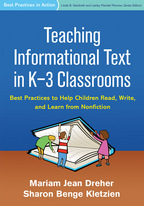Teaching Informational Text in K-3 Classrooms
Best Practices to Help Children Read, Write, and Learn from Nonfiction
Mariam Jean Dreher and Sharon Benge Kletzien
HardcoverPaperbacke-bookprint + e-book
Hardcover
orderSeptember 18, 2015
ISBN 9781462522279
Price: $48.00 192 Pages
Size: 7" x 10"
Paperback
orderSeptember 19, 2015
ISBN 9781462522262
Price: $32.00192 Pages
Size: 7" x 10"
Ideal for Professional Development
Includes Common Core Content
Includes Common Core Content
Specifically designed for K-3 teachers, this accessible guide describes ways to use informational text creatively and effectively in both reading and writing instruction. The book presents lessons, read-alouds, and activities that motivate students to engage with a wide variety of exemplary texts. Links to the Common Core State Standards (CCSS) are explained throughout. Key topics include how to build academic vocabulary, balance fiction and nonfiction, and address the needs of English language learners. Examples from diverse classrooms and end-of-chapter discussion questions and engagement activities enhance the book's utility as a professional development resource. Reproducible handouts and other tools can be downloaded and printed in a convenient 8½“ x 11” size.
This title is part of the Best Practices in Action Series, edited by Linda B. Gambrell and Lesley Mandel Morrow.
“This is a book to keep on my desk and refer to throughout the year! It’s well written, fast paced, easy to understand, and full of ready-to-use ideas. It will be valuable for primary-grade teachers and teachers-in-training, and it’s perfect for a teacher study group. Students who are lucky enough to have a savvy teacher using this book will have more and better access to information books and be better prepared for their future education and careers.”
—Laura Broach, MEd, reading specialist; past president, Massachusetts Reading Association
“An excellent guide. The inclusion of classroom examples and many hands-on application tools—such as the extensive list of sources for informational text, reproducible checklists for implementing the practices discussed, and rubrics for choosing quality texts—makes this a resource of great utility for the classroom and preservice teacher. The questions, reflections, and classroom engagement activities at the end of each chapter make the book a good choice for teacher-led book study groups. Students in primary-grades literacy methods classes at the graduate and undergraduate levels will find it a valuable text.”
—Carol A. Donovan, PhD, Director, Belser–Parton Literacy Center, University of Alabama
“This teacher-friendly, resource-rich book provides the reader with both contextual understanding of using informational text and practical knowledge of how to implement the strategies immediately in the classroom. Maximizing instructional time to incorporate the teaching of nonfiction is paramount to achieving high standards. The authors supply useful planning tools, samples of student work, and models for replication. This is a 'must read' for K-3 teachers, reading specialists, special educators, academic coaches/instructional support teachers, and administrators.”
—Ryan T. Monaghan, EdD, K-12 Supervisor of Instruction and Language Arts, Owen J. Roberts School District, Pottstown, Pennsylvania
“This book delivers on its title in a powerful way. It guides teachers to tackle the current demand for effective use of informational text in the primary grades. The authors skillfully show how to take students through the process of digging into, enjoying, developing, and learning from informational text in the classroom through reading, writing, and research. The format and writing style are ideal for a group book study for professional learners. I have been in education for more than 30 years, and find this book to be particularly helpful.”
—Elisa Magee, MEd, academic coach, Chandler, Arizona, public schools
Table of Contents
1. Supporting Motivation and Achievement with Informational Text2. Developing Classroom Libraries with a Full Range of Informational Text
3. Choosing Information Books and Websites for the Classroom
4. Using Information Books for Read-Alouds
5. Comprehension and Close Reading of Informational Text
6. Vocabulary Development with Informational Text
7. Using Information Books and Internet Resources for Research
8. Teaching Children to Write Informational Text
9. Putting It All Together
About the Authors
Mariam Jean Dreher, PhD, is Professor in the Department of Teaching and Learning, Policy and Leadership at the University of Maryland, College Park. Previously she was an elementary classroom teacher and Title I specialist. Her research interests include ways to integrate informational text into literacy instruction to enhance students’ comprehension, vocabulary, and motivation. Dr. Dreher has published numerous articles and books and has served on many editorial advisory boards, receiving the Outstanding Reviewer Award from the Journal of Literacy Research. She is a consultant to National Geographic Children’s Books on a series of information books for young children. Dr. Dreher is also a recipient of a Fulbright Senior Specialist Grant and was recently awarded an honorary doctorate from the University of Oulu, Finland.Sharon Benge Kletzien, PhD, is Professor Emerita at West Chester University of Pennsylvania, where she was Chair of the Literacy Department, taught reading courses, and supervised the Reading Center. Previously she served as a reading specialist in elementary, middle, and high schools. Her research focuses on the areas of comprehension, using information books for instruction, and supporting students who struggle with reading. Dr. Kletzien has published many articles and book chapters and serves on the editorial boards of several major literacy journals. She is a recipient of the Outstanding Student Research Award from the American Educational Research Association, Division C, and the Program of Excellence Award from the National Council for the Social Studies.
